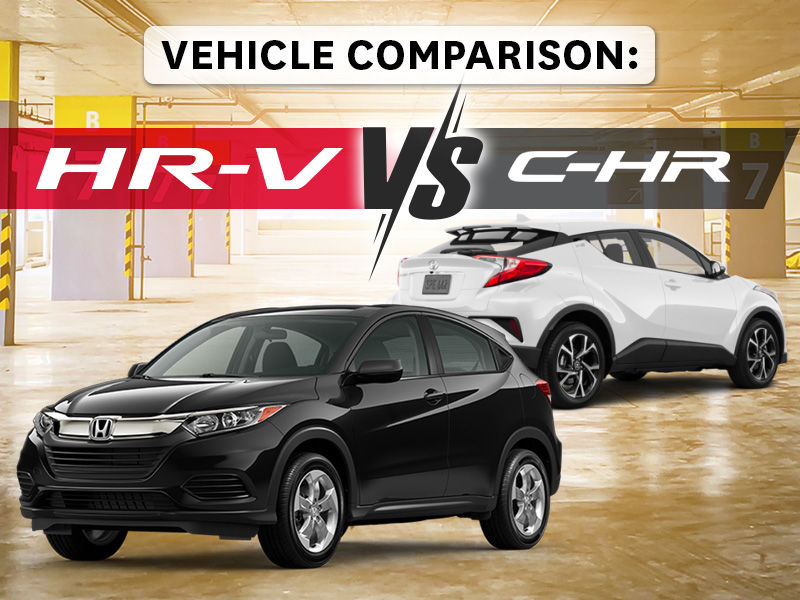2021 Honda HR-V vs. Toyota C-HRAt Calgary Honda


|
|
||
|
Give the Honda HR-V a little time to build speed, and you'll be treated to a lively ride. The HR-V keeps its composure as it glides around the turns, and easily maneuvers around tight spots. The optional all-wheel-drive system adds grip around corners and on slippery surfaces. However, its stiffer suspension can create a choppier ride than in the Toyota C-HR.
Overall, the HR-V’s optional all-wheel drive helps give it the edge over the C-HR when it comes to ride and handling. The HR-V stands out for its excellent fuel efficiency ratings. It logs 28 mpg around town and 34 mpg on the highway. All-wheel-drive models deliver the same mpg figures as the Toyota C-HR: 27/31 mpg city/highway.
|
VS. |
The Toyota C-HR delivers good performance on the road. It may be slow to accelerate – and merging onto a highway might prove difficult at times, but the ride is still comfortable the subcompact SUV provides a comfortable ride once it gets going. While not exactly sporty, the C-HR can maintain itself around tight turns and corners. As for fuel economy, the 2021 C-HR achieves average fuel economy for the subcompact SUV segment. It delivers an EPA-estimated 27 mpg in the city and 31 mpg on the highway. |
|
|
||
| The Honda HR-V’s cabin has a modern feel, accented with soft plastics, attractive cloth upholstery, and plenty of room. Its styling is more daring than what you might expect from a Honda, and the cabin design succeeds overall. Combined with quality fit-and-finish, the HR-V takes the win in this category. |
VS. | The subtle use of diamond-shaped designs and various textures throughout its interior gives the Toyota C-HR a handsome look. Its cabin layout is attractive, but its use of hard plastic pieces cheapen its look. |
|
|
||
|
The Honda HR-V also seats five people on comfortable cloth seats with plenty of head- and legroom. Upper trims add leather trim and an eight-way power-adjustable driver seat. There is plenty of legroom for back-seat passengers, but headroom can feel tight due to the sloping roofline. |
VS. | The five-passenger Toyota C-HR provides a comfortable ride on soft cloth upholstery. An eight-way power-adjustable driver seat is available. The cabin is spacious, providing front-seat occupants with plenty of head- and legroom. Passengers in the rear get ample legroom, but the C-HR’s small rear windows and sloping roofline can make those seats feel cramped. |
|
|
||
|
The 2021 Honda HR-V includes a 7" display audio system, multi-angle rearview camera, Apple Carplay and Android Auto, available proximity keyless entry and push button start, and available 180-watt am/fm Audio System.
|
||
|
|
||
|
Comparatively, the base HR-V comes equipped with a rearview camera. The EX trim includes safety equipment such as adaptive cruise control and automatic high-beam headlights. |
VS. |
The C-HR comes with a long list of standard safety equipment including forward collision warning, automatic emergency braking, adaptive cruise control, and automatic high-beam headlights. Road sign assist is newly standard for 2021. Blind spot monitoring and rear cross traffic alert are available. |
|
|
||
|
Alternatively, the Honda HR-V boasts one of the largest cargo holds in the subcompact SUV class. With 24.3 cubic feet of space behind the back seats, the HR-V provides plenty of room for a few bags of groceries. Fold down the rear seats for a generous 58.8 cubic feet of cargo space. All-wheel-drive models provide 23.2 cubic feet of room behind the rear row, and between 55.9 and 57.6 cubic feet with the back seats folded down, depending on trim level. |
VS. |
These subcompact SUVs from Toyota and Honda share many similarities, but cargo space isn't one of them. With a mere 19.1 cubic feet of space behind the rear seats, the Toyota C-HR offers one of the smallest cargo holds in the segment. The back seats fold down to reveal a total of 37 cubic feet. |
|
|
||









